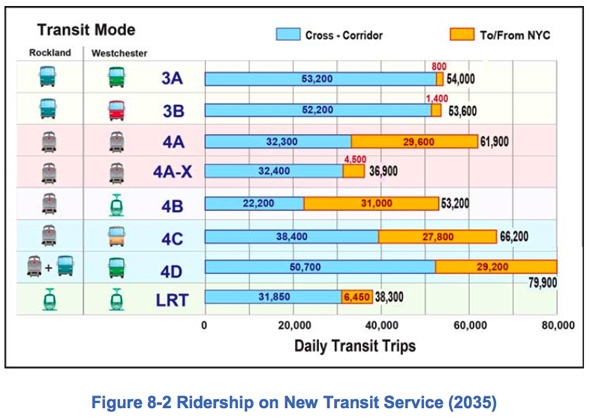
According to the State of New York, spending $5.2 billion on a new Tappan Zee Bridge is affordable, but spending another $1 billion for a 30-mile bus rapid transit corridor is a bridge too far.
Affordability, of course, is subjective. If the state were truly broke, Governor Andrew Cuomo might decide he had to close the Tappan Zee entirely, save $5 billion and let drivers head to the George Washington Bridge or Bear Mountain Bridge. That was never going to happen; the state found $5 billion for a new bridge because replacing the Tappan Zee is seen as necessary. "Affordable," in this case, really just means "worth the cost."
If Cuomo viewed building transit across the Tappan Zee as vital, transit might be "affordable" as well. So let's take a look at what doesn't qualify as a vital transportation project under Cuomo's leadership.
According to the Tappan Zee transit mode selection report, put together by the State DOT, the Thruway Authority and Metro-North when David Paterson was governor, building just the BRT component of the transit would cost less than $1 billion. For that price, compared to a no-build scenario, New York would get the following benefits:
- 54,000 additional commuters would ride transit per day.
- During every morning rush, the transit line would save commuters 4,400 hours of travel time.
- Every day, during just the four hours of the a.m. peak, BRT would reduce greenhouse gas emissions by 59 tons and carbon monoxide emissions by 2.3 tons.
- The BRT system would conserve 22,325 gallons of fuel each morning.
Those numbers, from 2009, probably understate the value of transit. The projections assumed the ARC tunnel would be finished, which would have significantly increased transit capacity in Rockland County. With Tappan Zee transit but no ARC, some would-be ARC riders might find themselves riding across the Tappan Zee instead.
The 2009 calculations also compare a bridge with highway and transit improvements to the current bridge, rather than to a bridge with just the highway improvements, as the Cuomo administration now plans to build. As a result, those figures likely underestimate the impact of the BRT system by a significant margin. Adding the more expensive Metro-North line would boost transit ridership even further.
Let's put some dollar values on the benefits of the BRT-only option:
- Assuming gas costs $4 a gallon and every morning rush hour driver returns in the evening, BRT alone would save New Yorkers around $200,000 in gas costs each and every weekday.
- Transit would provide another $200,000 a day in value from time savings, using the The Partnership for New York City's conservative estimate of $23 per vehicle hour as the value of lost time in a 2006 report.
- Not even counting weekend travel, these savings add up to about $100 million over the course of a year.
Then consider the extra pollution, additional traffic crashes, and land eaten up by sprawl. By building the Tappan Zee without transit, the Cuomo administration is forcing New Yorkers to absorb those costs.
The state government says New York can't afford to build transit. But perhaps the Cuomo administration should take a page from the decade of study that went into the Tappan Zee project, and ask whether we can afford not to.






